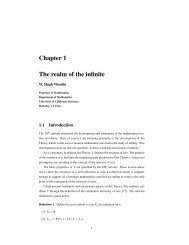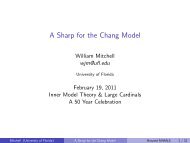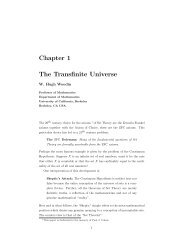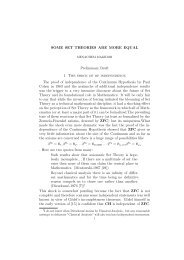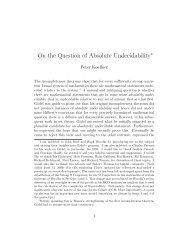The Continuum Hypothesis - Logic at Harvard
The Continuum Hypothesis - Logic at Harvard
The Continuum Hypothesis - Logic at Harvard
You also want an ePaper? Increase the reach of your titles
YUMPU automatically turns print PDFs into web optimized ePapers that Google loves.
Now to arrive <strong>at</strong> this conclusion one must (in the background theory) bein a position to prove Con(PA) (since this assumption is required to applythe second incompleteness theorem in this particular case). Thus, from theperspective of the background theory used to argue th<strong>at</strong> the above modelsare legitim<strong>at</strong>e candid<strong>at</strong>es, the models in question s<strong>at</strong>isfy a false Σ 0 1 -sentence,namely, ¬Con(PA). In short, there is a lack of harmony between wh<strong>at</strong> isheld <strong>at</strong> the meta-level and wh<strong>at</strong> is held <strong>at</strong> the object-level.<strong>The</strong> only way out of this difficulty would seem to be to regard eachviewpoint—each articul<strong>at</strong>ion of the multiverse conception—as provisionaland, when pressed, embrace pluralism concerning the background theory.In other words, one would have to adopt a multiverse conception of themultiverse, a multiverse conception of the multiverse conception of the multiverse,and so on, off to infinity. It follows th<strong>at</strong> such a position can never befully articul<strong>at</strong>ed—each time one <strong>at</strong>tempts to articul<strong>at</strong>e the broad multiverseconception one must employ a background theory but since one is a pluralistabout th<strong>at</strong> background theory this pass <strong>at</strong> using the broad multiverse to articul<strong>at</strong>ethe conception does not do the conception full justice. <strong>The</strong> positionis thus difficult to articul<strong>at</strong>e. One can certainly take the pluralist stance andtry to gesture toward or exhibit the view th<strong>at</strong> one intends by provisionallysettling on a particular background theory but then advoc<strong>at</strong>e pluralism regardingth<strong>at</strong> when pressed. <strong>The</strong> view is thus something of a “moving target”.We shall pass over this view in silence and concentr<strong>at</strong>e on views th<strong>at</strong> can bearticul<strong>at</strong>ed within a found<strong>at</strong>ional framework.We will accordingly look <strong>at</strong> views which embrace non-pluralism with regardto a given stretch of m<strong>at</strong>hem<strong>at</strong>ics and for reasons of space and becausethis is an entry on set theory we will pass over the long deb<strong>at</strong>es concerningstrict finitism, finitism, predic<strong>at</strong>ivism, and start with views th<strong>at</strong> embracenon-pluralism regarding ZFC.Let the broad multiverse (based on ZFC) be the collection of all modelsof ZFC. <strong>The</strong> broad multiverse conception of truth (based on ZFC) is thensimply the view th<strong>at</strong> a st<strong>at</strong>ement of set theory is true simpliciter if it isprovable in ZFC. On this view the st<strong>at</strong>ement Con(ZFC) and other undecidedΠ 0 1-st<strong>at</strong>ements are classified as indetermin<strong>at</strong>e. This view thus faces adifficulty parallel to the one mentioned above concerning radical pluralism.This motiv<strong>at</strong>es the shift to views th<strong>at</strong> narrow the class of universes inthe multiverse by employing a strong logic. For example, one can restrictto universes th<strong>at</strong> are ω-models, β-models (i.e. wellfounded), etc. On theview where one takes ω-models, the st<strong>at</strong>ement Con(ZFC) is classified as true21





